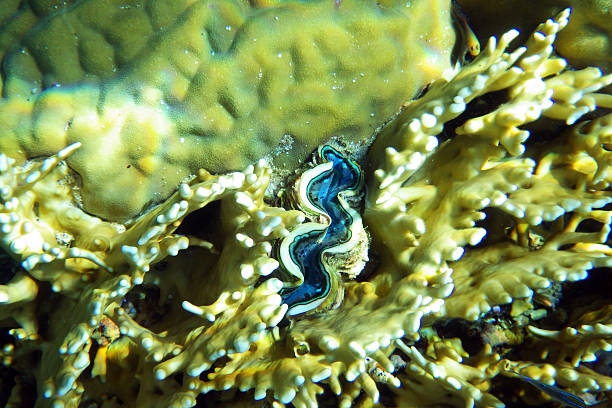ANIMAL: Small Giant Clam/Maxima Clam Tridacna maxima Type of Animal: Cockle Habitat: Reef surfaces, illuminated sand areas, partly/fully embedded in coral, reef slopes/tops in shallow clear waters, limestone substrates, coral rubble, on top of living corals, nestled between corals in strongly illuminated areas, shallow waters w/ intense sunlight, coral boulders in shallow reefs, reef rocks, found as deep as 65.61 ft Location(s): Indo-Pacific Appearance: Bright blue/green/brown mantle, furrowed shell edges, colorful clam species, large shell Food/Diet: Make food for themselves in 4 ways-firstly, they have large amounts of symbiotic single-celled dinoflagellate algae (zooxanthellae) in tissues-due to these clams needing well-lit habitats, algae may make too much food for themselves giving extra carbon/glucose to clam. Secondly, zooxanthellae can be eaten by amoebid cells within host clam. Thirdly, they can absorb nutrients from water. Fourthly, they can act as filter-feeders, straining phytoplankton/zooplankton/detritus/algae w/ gills. Status in Wild: Stable Conservation: Use in aquaculture reducing demand for wild-caught clams Lifestyle: Mostly colonial but can be solitary at deeper depths Additional Info: Called: Young: Trocophore Group: Colony/Aggregation/Bed Weight: 40-145 lbs Gestation: 12 hours Life Span: 50-70 years in captivity, 200-250 years in wild Length: Adult: 7.9-14 in Juvenile: 2-4 in Main predators are parasitic/predatory snails, bristleworms, sea stars, crabs, fish, & sea snakes. Highly sought after in aquarium trade due to coloration & smaller size in comparison to true giant clam. Attractive colors result of crystalline pigment cells. Large shell adheres to substrate by byssus (tuft of long tough filaments) protruding from hole next to hinge. Attractive colors thought to protect clam from intense sunlight and/or bundle light enhancing algae’s photosynthesis. Reproduction stimulated by lunar cycle, time of day, & presence of other eggs/sperm. They’re very slow growers after reaching maturity. Fun Fact(s): Start life as free-swimming larvae, then developing into new larval stage capable of filter-feeding. Develop feet at 3rd larval stage, allowing it to alternately swim/rest. Become juveniles at 8-10 days old, when they acquire zooxanthellae, starting symbiotic relationship. Juveniles become males at 2-2.5 years old, eventually becoming hermaphroditic once they reach 5.9 in in length. Due to being hermaphrodites much of their life, sperm released 1st followed by eggs, avoiding self-fertilization.
